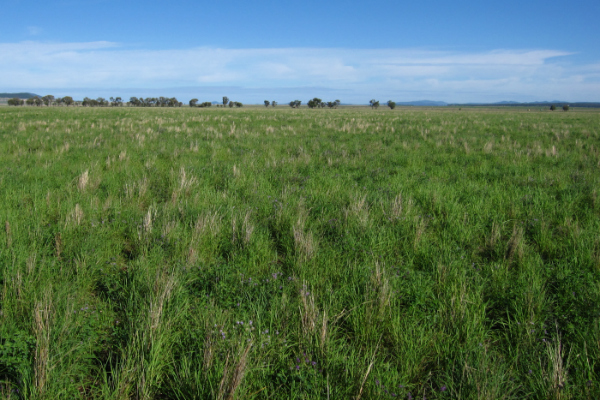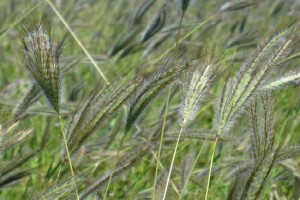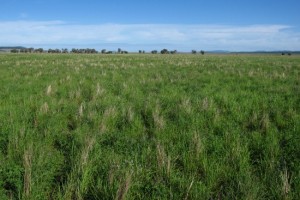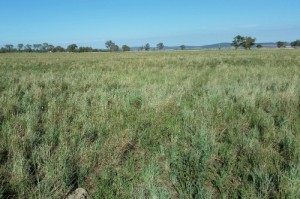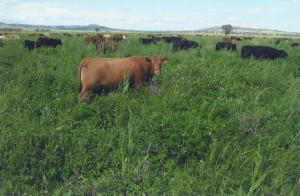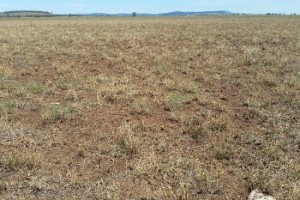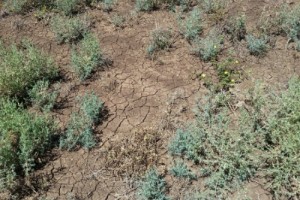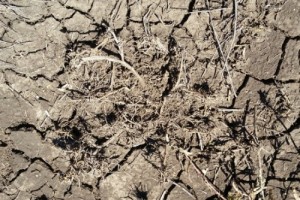As I mentioned last week, I have been asked by a subscriber that has visited our farm about how we transitioned country from full zero till cropping to perennial pasture. We have two alluvial self-mulching black soil paddocks that have had two quite different approaches, with different outcomes in the short and long term. Sharing these examples with you may offer some helpful learnings. The outcomes – after a few dry years are worlds apart right at the moment.
In 2008, Derek and I decided that we wanted our business to be solely grazing based. This decision was made after Holistic Management training and discussion about what we really wanted out of life (but that’s an aside in this article). I would like to share with you how we took two different paddocks from cropping to pasture, and the current outcomes of each.
When we chose to take land from cropping to pasture Derek and I considered the best way to go about it. We were aware of situations where farmers had left country and allowed natural succession of plants to occur in order to establish a pasture, while more often others choose introduced pasture mixes, planted at considerable expense. We did a bit of both.
Natural Grass Succession – paddock 1
The season before we were about to change, just prior to our last sorghum crop, there was an amazing germination of liverseed and barnyard grasses (both annual, prolific seeding and a challenge to summer row croppers!). We contemplated not planting the final sorghum crop and keeping these annual grasses as cattle feed. We ended up planting the sorghum crop, which grew over the 2008/09 summer and harvested in March. We then strip grazed this stubble (and whatever weeds were present) after harvest, with a mob of 300 cows with their calves. At this stage the cattle walked up to 2km back to water – as this had been cropping country and there was no water access on this part of the farm. The walk to water was along an area that contained many native Australian grasses such as Queensland bluegrass (Dichanthium sericeum), Plains grass (Austrostipa aristiglumis) and Wallaby grass (Austrodanthonia).
By May/June it had been very dry and the paddock looked like a fallow, with sorghum stubble eaten and bashed by the cattle and weeds consumed. We used no herbicide control and in early winter we planted a very light rate (0.5kg/ha, 0.45lb/ac) of lucerne (alfalfa) and a small amount of arrowleaf clover (a non-bloating clover). We planted this dry with a double disc opener and press wheel planter. We let the lucerne and clovers establish and go to seed in the Spring, at which point we grazed it (along with some annual ryegrass, wild oats and everything else that had come). By summer we had quite a good amount of liverseed and barnyard grass (which we expected given the amount in the previous 2 summers, and this was the reason for planting just the legumes and not trying to establish an introduced grass pasture). We also found some native grass plants such as Queensland blue grass, and a little wallaby grass scattered across the paddock – seed which was most likely carted from the area which the cattle were walking through on the way back from the water.
Over that first summer we also had an amazing population of fleabane present (not good!), which was all that could be seen when driving past on the public road adjoining this part of our farm! However, we continued to graze (and not spray) – ensuring that any perennial species were recovered before regrazing. As perennial grass plant numbers increased (over the next couple of seasons), the fleabane decreased to the point where it is now virtually non-existent.
During the second year, we installed a 63mm (2 ½”) poly water pipe through the middle of the paddock, with a single wire electric fence along that line. We installed access points at intervals along that pipe to utilise our portable water troughs throughout the paddock (see blog WATER SYSTEMS FOR LIVESTOCK, September 2014) and erected temporary electric fences to keep animals in smaller areas of the paddock (5-8 Ha/ 12-20 Ac). The fencing and portable water meant that animals were confined to areas, where their urine and dung also stayed, leaving this fertility in the paddock. We believe this grazing style helped to spread seed around the paddock through the animals rumen and on their coats (native grass seed can be very fluffy and easily stick to smooth or coarse coats).
This is the now the sixth summer since we stopped cropping. The paddock has improved with each summer as the lone bluegrass plants were allowed to seed and small colonies formed around them, which then spread to cover the paddock. The lucerne (alfalfa) has increased in density in areas and the arrowleaf appears when the season is right. There are also increasing colonies of wallaby grass (Austrodanthonia), a cool season active grass, helping to fill the winter feed gap. Plains grass and Emus foot (native legume vine) are also present, among other things. We are very pleased with the groundcover and productivity of this paddock.
In wetter times
Currently
A monitoring point on this paddock is telling us that things continue to improve. We have transitioned (at last measurement) from ground cover of 87% in 2012 to 88% in 2014. While these are similar ground cover levels, the difference is in the actively growing plants, at 69% versus 51% 2 years earlier (the remainder of the ground cover is made up of litter).
Planted introduced species – paddock 2
We took a second cropping block to pasture at a similar time. The final crop here was a wheat crop harvested in December 2009. Our climate here on the Liverpool Plains of NSW means that we have most pasture growth in summer and our challenge in this pasture system is to fill our winter feed gap. This gap is somewhat filled in a year where we get a rainfall event that germinates annual legumes in Autumn (Fall), but rain at this time of year is unreliable.
In order to help fill our potential gap in quality feed over winter, we planted a winter active pasture of fescue, chicory, lucerne, arrowleaf clover and berseem clover in June 2010. We had controlled any weed growth in the fallow leading up to planting with herbicides.
We had a good wet Spring that year and the pasture growth was prolific – as you can see we had masses of feed. The fescue however has never been amazing (there was not a fantastic establishment), the clovers are only annuals and chicory biennial. We were also planning on natural colonisation of native summer grasses, encouraged by appropriate grazing. There was less opportunity than paddock 1 to strategically graze out of a native grass pasture into this to encourage seed spread.
The pasture was good for the first few years as seasons provided germination of the annual clovers and chicory, and the wetter seasons suited the fescue.
By the summer of 2013 odd blue grass plants had spread to small clusters across the paddock, and we anticipated the spread in subsequent seasons like we had seen in the previously described paddock. We have however since had two very dry summers, so there has been little opportunity for bluegrass establishment. Combine that with some recent dry winters, and we have had limited germination of the annual species of chicory and clover. So, with the perennial summer grasses not establishing well yet, due to dry summers and less than ideal conditions to germinate the annual winter species – it has left us with poor ground cover.
Whilst it has been extremely dry, lucerne still has the ability to draw the last bit of moisture from a soil profile and we have regrazed this paddock to make use of the recovered lucerne.
Until recently, whilst we didn’t have much groundcover in terms of perennial plants or active plants growing due to the dry – we did have plant litter on the ground from the bulk of material carried over from previous good seasons. Over the last 18 months however, there has been little growth to replace that plant material and oxidation of the old litter has occurred. Adding to that, we have regrazed the lucerne (which has an amazing ability to draw moisture past the point that other plants can), which removed and incorporated some of the litter that was present as ground cover, further reducing plant residue litter and leaving bare earth exposed – which is not what we want. A pretty major contrast to paddock 1.
Currently
Nature will always fill a void and this was no exception – with opportunistic weeds like soft roly poly (tumbleweed) germinating on small showers of rain in some areas.
WHAT HAVE WE LEARNED FROM THIS?
Allowing natural succession of plants to establish (or improve) a pasture can work
It is essential to have perennial species resilient in our climate to provide ground cover throughout the year
Plant Choice
Planting the lucerne with the fescue (which is a marginal species for this region anyway) may not have been the best combination. Lucerne has a particularly amazing ability to pull moisture from soil. I’m not referring to depth here, but rather its ability to pull moisture from a given amount of soil. Given this fact, the combination of lucerne (although only a light planting) with the fescue, may not have been the best selection. In hot dry times, fescue can struggle in this area, but the lucerne may have added an extra moisture stress to it.
Would we change the way we grazed this block? I don’t think we have actually overgrazed species in this paddock (ie. grazed them when they were not recovered). We did regraze lucerne that had regrown and set seed, whilst other plants hadn’t regrown – but the other plants simply had not grown at all (like a closed season on a Holistic Management graze plan). In regrazing the lucerne however, it was then able to regrow (drawing every last bit of moisture from the profile) and further placing moisture stress on the struggling fescue plants.
When the black soils of this plain dry right out – they crack right open, become extremely dry and take a really large amount of rain to fill the profile.
Had we have locked this paddock up, the lucerne may have virtually halted its growth after setting seed and not taken as much moisture from the soil profile. One consequence of that decision would be less animal production in the near term.
Another good season will see us have a bulk of clovers and chicory again and good production, but we want to concentrate on more perennial species that will help to hold soil.
Our outcomes are the result of our past decisions, but while we have somewhat created this ground cover challenge…..
we also have the skills to solve such challenges at little cost.
Grow what grows
If it is native to your area, it no doubt grows well in your environment. The introduced species I referred to above would most certainly outperform the natives in terms of livestock weight gain in a favourable season or under irrigation, but this is offset by what we have seen in recent dry times. Mark Shepard of Restoration Agriculture states – ‘grow what grows in your area’. Sounds like a pretty basic statement, but what we have seen in these two pastures is what Mark is getting at. The species that are native to your area will be the most resilient.
We are very confident that we will get native perennials established in paddock 2 when we get the rainfall, just as we did in the previous paddock, however this will take time and there will be lower succession, less palatable plants in the interim. We might make more of an effort to strategically graze from paddocks that have bluegrass in them to increase the speed of colonisation. What more can we do to speed up the process of increasing plant diversity and density in this paddock, that works with nature?
Other options include planting a multispecies fodder cover crop once the season improves, to fill the bare ground (see blog THE ‘NEW’ COVER CROPPING, July 2014) and speed up the diversity process and health of the soil or we could lock up this paddock entirely for an extended period when we do receive rain. The clovers and chicory will still be there when the season is right, but we need to establish more perennials that will persist.
Ground cover and diversity advantages?
One last thing to note is the difference in the two paddocks now. Conventional thinking might expect that the plants in the paddock that is currently lacking ground cover and plant density to be in better condition due to less competition, however this is not so. The paddock that has established with the natural succession of grasses has a much greater number of plants and species, and is also still growing better despite the dry conditions, similar grazing history to paddock 2 and also having moisture drawing lucerne present. Later germinated roly poly in paddock 2 is even dying!
I think this difference is testament to both diversity and to the benefits of ground cover and the advantages they can provide. Remember the study from North Dakota with the single species vs multi species cover crop plot trials? In a very dry season (just 1” rain post planting), the multi species plot was so much better than the single species, which were all but dead with very poor ground cover.
We are not pleased with the lack of ground cover in the second paddock described and would do a few things differently next time, but we wanted to share this with you, as it is often our challenges that can provide the most learning.
If you have an opinion, comment or suggestion, why not share it.

